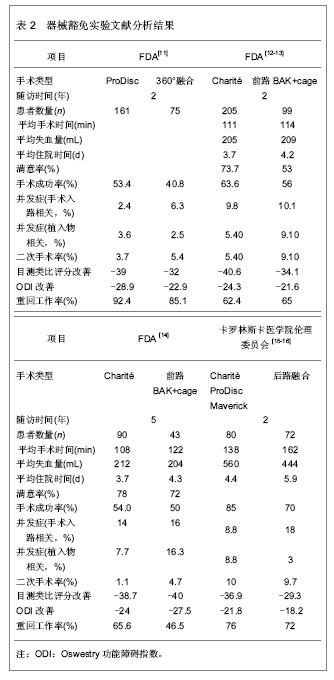| [1] Blondel B, Tropiano P, Gaudart J, et al.Clinical Results of Total Lumbar Disc Replacement Regarding Various Aetiologies of the Disc Degeneration: A Study With a 2-Year Minimal Follow-up. Spine.2011;36(5): E313-E319.
[2] Van Steen brugghe MH.Improvements in joint prosthesis. French Patent. 1956:122-128.
[3] Fernstrom U. Arthroplasty with intercorporal endoprothesis in herniated disc and in painful disc. Acta Chir Scand.1966; 357:154-159.
[4] Bertagnoli R, Kumar S. Indications for full prosthetic disc arthroplasty: a correlation of clinical outcome against a variety of indications. Eur spine J.2002;11(2): S131-S136.
[5] Tropiano P, Huang RC, Girardi FP, et al. Lumbar disc replacement: Preliminary results with ProDisc II after a minimum follow-up period of one year. J Spinal Disord Tech. 2003;16(4):362-368.
[6] Tropiano P, Huang RC, Girardi FP, et al. Lumbar total disc replacement.Seven to eleven-year follow-up. J Bone Joint Surg Am. 2005;87(3):490-496.
[7] Bertagnoli R, Yue JJ, Shah RV, et al. The treatment of disabling single-level lumbar discogenic low back pain with total disc arthroplasty utilizing the Prodisc prosthesis: a prospective study with 2-year minimum follow-up. Spine.2005; 30(19): 2230-2236.
[8] Lemaire J, Ali ES, Skalli W. Clinical and Radiological Outcomes With the Charite Artificial Disc. 2005;18(4): 353-359.
[9] Putzier M,Funk JF,Schneider SV, et al. Charité total disc replacement--clinical and radiographical results after an average follow-up of 17 years. Eur Spine J.2006;15(2): 183-195.
[10] Thierry David MD. Long-term Results of One-Level Lumbar Arthroplasty: Minimum 10-Year Follow-up of the CHARITE Artificial Disc in 106 Patients. Spine.2007; 32(6):661-666.
[11] Zigler J, Delamarter R, Spivak JM, et al. Results of the prospective, randomized, multicenter Food and Drug Administration investigational device exemption study of the ProDisc-L total disc replacement versus circumferential fusion for the treatment of 1-level degenerative disc disease. Spine. 2007; 32(11):1155-1162.
[12] Blumenthal S, McAfee PC, Guyer RD, et al. A prospective, randomized, multicenter Food and Drug Administration investigational device exemptions study of lumbar total disc replacement with the CHARITE artificial disc versus lumbar fusion: part I: evaluation of clinical outcomes. Spine.2005; 30(14):1565-1575.
[13] McAfee PC,Cunningham B,Holsapple G,et al.A prospective, randomized, multicenter Food and Drug Administration investigational device exemption study of lumbar total disc replacement with the CHARITE artificial disc versus lumbar fusion: part II: evaluation of radiographic outcomes and correlation. Spine.2005;30(14):1576-1583.
[14] Guyer RD, McAfee PC, Banco RJ, et al. Prospective, randomized, multicenter Food and Drug Administration investigational device exemption study of lumbar total disc replacement with the CHARITE artificial disc versus lumbar fusion: five-year follow-up. Spine J.2009;9(5): 374-386.
[15] Berg S, Tropp HT, Leivseth G. Disc height and motion patterns in the lumbar spine in patients operated with total disc replacement or fusion for discogenic back pain. Results from a randomized controlled trial. Spine J.2011; 11(11): 991-998.
[16] Berg S, Tullberg T, Branth B, et al. Total disc replacement compared to lumbar fusion: a randomized controlled trial with 2-year follow-up. Eur Spine J. 2009;18:1512-1519.
[17] 詹姆斯.J.Y..脊柱功能重建外科学:高级理论和技巧[M].邹德威,译. 北京:人民军医出版社,2008.
[18] Bertagnoli R, Yue JJ. Lumbar total disc arthroplasty in patients older than 60 years of age: a prospective study of the ProDisc prosthesis with 2-year minimum follow-up period. J Neurosurg Spine.2006;4(2):85-90.
[19] Siepe CJ, Mayer HM, Wiechert K, et al. Clinical results of total lumbar disc replacement with ProDisc II: three-year results for different indications. Spine.2006;31(17):1923-1932.
[20] Bertagnoli R,YueJJ,Fenk-Mayer A,et al.Treatment of symptomatic adjacent-segment degeneration after lumbar fusion with total disc arthroplasty by using the prodisc prosthesis: a prospective study with 2-year minimum follow up. J Neurosurg Spine.2006;4(2):91-97.
[21] Glenn JS,Yaker J,Guyer RD, et al. Anterior discectomy and total disc replacement for three patients with multiple recurrent lumbar disc herniations. Spine J.2011;11(9): e1-e6.
[22] Blondel B, Tropiano P, Gaudart J, et al.Clinical Results of Total Lumbar Disc Replacement Regarding Various Aetiologies of the Disc Degeneration: A Study With a 2-Year Minimal Follow-up. Spine.2011;36(5): E313-E319.
[23] Sott AH , Harrison DJ. Increasing age does not affect good outcome after lumbar disc replacement. International orthopaedics.2000;24(1):50-53.
[24] Rohan MX, Ohnmeiss DD, Guyer RD, et al. Relationship between the length of time off work preoperatively and clinical outcome at 24-month follow-up in patients undergoing total disc replacement or fusion. Spine J.2009; 9(5):360-365.
[25] Sasso RC, Foulk DM,Hahn M,et al.Prospective, randomized trial of metal-on-metal artificial lumbar disc replacement: initial results for treatment of discogenic pain. Spine.2008;33(2):123-131.
[26] Richard D, Guyer SG, Tromanhauser, et al. An economic model of one-level lumbar arthroplasty versus fusion. Spine J.2007;7(5):558-562.
[27] McAfee PC,Cunningham BW,Devine J,et al.Classification of heterotopic ossification(HO) in artificial disc replacement. J Spine Disord Tech.2003; 16(4):384-389.
[28] Park SJ, Kang KJ, Shin SK, et al. Heterotopic ossification following lumbar total disc replacement. Int Orthop.2011;35(8): 197-201.
[29] Punt IM, Visser VM, van Rhijn LW, et al. Complications and reoperations of the SB Charité lumbar disc prosthesis: experience in 75 patients. Eur Spine J.2008;17(1):36-43.
[30] Trouillier H, Kern P, Refior HJ, et al. A prospective morphological study of facet joint integrity following intervertebral disc replacement with the charite artificial disc. Eur Spine J.2006;15(2):174-182.
[31] Siepe CJ, Zelenkov P, Sauri-Barraza JC, et al. The fate of facet joint and adjacent level disc degeneration following total lumbar disc replacement: A prospective clinical, X-ray, and magnetic resonance imaging investigation. Spine.2010; 35(22): 1991-2003.
[32] Grauer JN,Biyani A, Faizan A,et al.Biomechanics of two-level Charité artificial disc placement in comparison to fusion plus single-level disc placement combination. Spine J.2006;6(6): 659-666.
[33] Qingan Z, Timothy S, Eyal I, et al. Kinematic evaluation of one- and two-level Maverick lumbar total disc replacement caudal to a long thoracolumabar spinal fusion. Eur Spine J.2012;21(5):S599-611.
[34] Cunningham BW, Nianbin H, Hassan S, et al. Revision strategies for single- and two-level total disc arthroplasty procedures: a biomechanical perspective. Spine J.2009;9(9): 735-743. |


